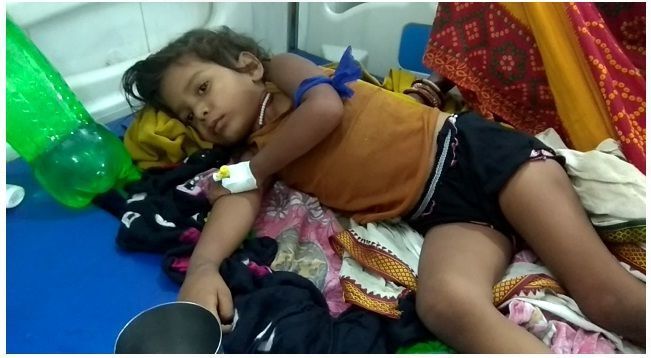Despite a plethora of government schemes, many villagers are still spending huge sums for treatment
The 6,500-odd residents of Adbar village in Haryana say they would love to have a doctor round the clock, child delivery facilities and a wider range of medicines. This is the story of many villages in India


A slim, young girl in a red salwar-kurta waves from a distance as I walk down a dirt track in Adbar village in Haryana’s Nuh district one recent Friday. A smile flits across her face as I get closer. I recognise her. She is Aaisa, a teenager I had met last year during one of my sorties to rural Haryana.
“This time, you must come home, meet my parents…” she says.
Soon, we are at Aaisa’s home and I am offered the welcome drink – fresh buffalo milk. Then, I am introduced to Aaisa’s father Zakir, and we settle down for a chat as dusk falls.
Adbar is one of those places which don’t fall in any of the grand narratives about Left versus Right.
Here it is about being left behind.
Zakir, who prefers to be known only by his first name, has six children – four daughters and two sons. He earns his living as a daily wage labourer. Things are not going too well; he does not get regular work; worries crease his forehead. “One or the other of my children is falling sick every now and then. My out-of-pocket expenditure on just healthcare for the family comes to Rs 15-20,000 a year,” he says.
Zakir wishes to educate all his children, but money is scarce. What is a man like him supposed to do when there are competing priorities, he asks.
There is a government sub-health-centre (SHC) within walking distance from Zakir’s home. It has been upgraded and is now one among the Health and Wellness Centres (HWC) showcased by the Narendra Modi government as part of Ayushman Bharat. The central government has promised to establish 150,000 such HWCs by 2022 by upgrading existing primary health centres and sub-centres.

Health and wellness centres — the less-publicised component of Ayushman Bharat — are meant to provide comprehensive primary healthcare. These include 12 items ranging from care in pregnancy and childbirth, neonatal and infant care, screening, prevention and management of non-communicable diseases as well as chronic communicable diseases like tuberculosis and leprosy.
More than 28,000 such HWCs are functional, according to official data; 40,000 is the target by the end of this year.
But, talking to residents in villages like Adbar, it becomes clear that there is a huge difference between official claims and the ground reality.
Much more needs to be done.
Zakir says an auxiliary nurse and midwife (ANM) and a doctor are present at the neighbourhood HWC every day and they do their best but the centre closes at 2 pm and stocks only basic medicines most of the time.
Residents of this village of 6,500 people say they would love to have a doctor round the clock, child delivery facilities and a wider range of medicines.
Zakir says the family often has to travel to Nuh town for medical treatment. “What do I do if my child falls very sick in the evening?”
As I sip my second glass of buffalo milk and chat with Aaisa and her sisters, I learn that the village’s water woes have not eased since my visit last year.
In Adbar, lives and dreams revolve around water. As you approach the village, you can see women and girls with plastic pots. They are on their way to fetch water from tube wells and storage tanks.
Adbar residents point to a giant community water storage chamber which has been lying unrepaired and dysfunctional for several years. Their everyday life would be easier if only this was repaired.
The village also suffers from long power outages. A tearful Aaisa tells me that her tenth-grade marks were not good and that she may have to switch to the Open School if she wishes to continue her studies.
I ask why her score was poor and if something was troubling her. Aaisa does not answer. She looks lost in her thoughts.
Which makes me realise that my question was unwise. How fair is it to benchmark teenaged girls from the poorest households in India’s most backward villages with others who are not so handicapped?

Adbar’s story is not unique. It is playing out in tens of thousands of villages across India. Despite a plethora of government schemes to provide healthcare, many are still spending huge sums for medical treatment. And when there is hardly any money at home, one of the casualties is education, especially of girls.
The Adbar HWC which I found locked late on a Friday afternoon has been recently painted a bright yellow. There is wonderful artwork on the wall. But villagers still have to travel far for their medical needs.
These villages which rarely grab headlines await the Union Budget with trepidation and expectation. Will their concerns figure in the grand narratives that are planned and formulated in big cities?
It is true that India has a large number of primary healthcare centres and sub-centres and some have been upgraded into HWCs, but they remain far from adequate.
A widely-quoted 2019 study by the Centre for Policy Research (CPR), a New Delhi-based think tank, showed that in 15 states, not a single one of these facilities meets the national public health standards set by the Ministry of Health and Family Welfare itself.
As on March 2018, out of the 1.58 lakh sub-centres, only 11,000 (a mere six per cent) met Indian Public Health Standards (IPHS) norms, according to the CPR study. The norms are a set of measures designed to improve the quality of health infrastructure in all health centres. These include government hospitals. They are intended to be the primary benchmarks for gauging quality improvement and functioning status of health facilities.
The central government points to state governments; it argues that they are responsible for adherence to norms. States say they are cash-strapped.
And so, the circular argument moves in all too familiar ways.
What about ‘vikas’, the poll-promise of development? I ask.
Zakir laughs. “That is vikas …” he says, pointing to the worn-out kutcha village road. “Sab koi kahta hai, karta kuch nahi.”
Patralekha Chatterjee is an award-winning journalist/columnist, and photographer focusing on development issues. Currently, her writing focuses on the intersection of politics and public policy on a range of inter-linked development issues for Indian and international media.
(Views are personal)

